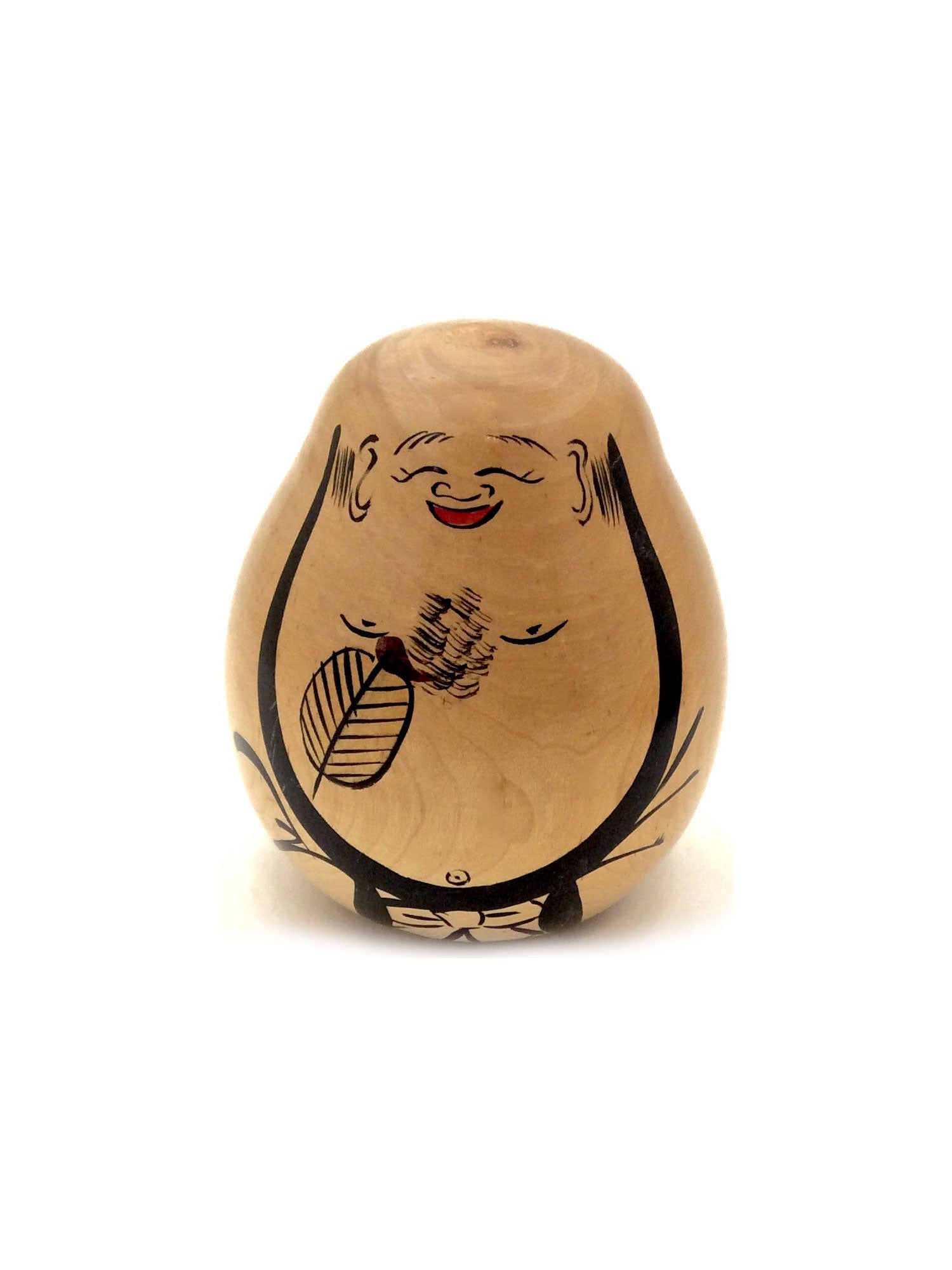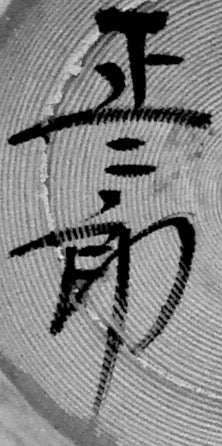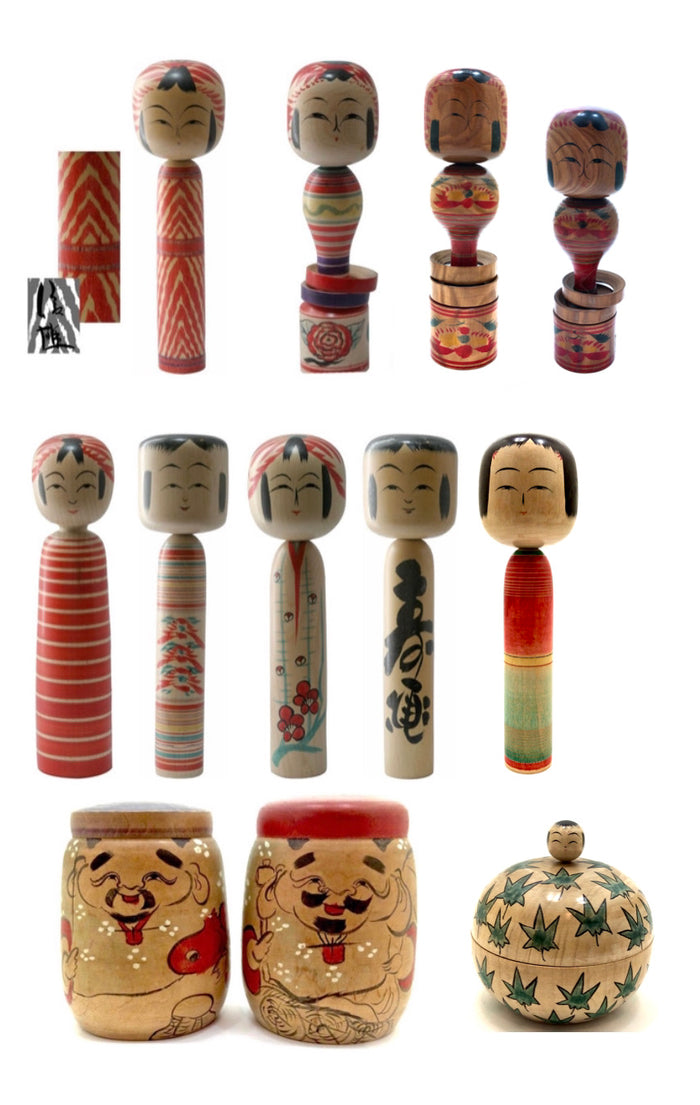

Vintage Tougatta Traditional Kokeshi by Sakai, Shojiro
Dimensions: 4-1/2” h
This vintage lathe-turned figure is quite unusual, and represents Hotei, the God of abundance and good health, Hotei is depicted as a “roly-poly” Buddhist monk with an expressive smiling face, big ears, hairy chest, navel, and elements of his encompassing robe. Here he is holding a fan keeping cool in the hot summer. Sakai-san was was an apprentice of Agatsuma, Kichisuke and known for his interpretations of the Seven Lucky Gods, (Benzaiten; Bishamonten; Dikokuten; Ebisu; Fukurokuju, Hotei, and Jurojin) which are always made of Kabanoki, (birch), because it would emphasize carved or painted ornamentation. The Seven Lucky Gods are known in Japan as Shichi Fukujin. Adapted from various Hindu, Buddhist, Taoist, and Shinto gods and saints, they were grouped together in Japanese folklore around the 17th Century. The piece is signed on the bottom of the figure.
Vintage Condition: The figure is in wonderful condition for their age, (“as is”), and retains the original craft/workmanship and commensurate with age. Any discoloration, chipping/cracking, surface wear, or structural damage is noted.

Japanese Traditional Kokeshi
Tougatta-Kei (Family)
Prefecture: Miyagi
Origin:
Tougatta dolls are considered the oldest family members of the Traditional school. They originated in the Tougatta Onsen in the Miyagi Prefecture and were subsequently produced at Aone Onsen and the cities of Sendai and Izumi. In the 1960s, Togatta craftsmen founded the Tougatta Kiji Union, a cooperative that gained the rights for reserved wood use from the Japanese Ministry of Forestry. Collectors easily find the Tougatta style in an interesting range of variations.
Collector's note – characteristics/painting style:
Tougatta dolls are easily recognized by their narrow, columnar body shapes, tapering at the shoulders, to a head that is wider than the rest of the doll, and more angular than round. The head is a squeeze-in type, and it is covered with a painting of a chrysanthemum. Most Tougatta dolls have split bangs (Hachi), with side fringes, crescent-shaped double-lidded eyes (many of which have arched brows), and a split nose or cat-type nose. Several have paintings of chrysanthemums (Kiku), plums (Ume), and irises (Ayame), usually in very stylized designs. The dolls decorated with plum branches and blossoms are associated with Aone Onsen. There is also a group that has ‘banded’ bodies primarily in red with some green. These are decorated in a circular-style painting known as Rokoru Moyo, which is done as the doll is turned on the lathe. The most collectible type is the Tougatta Mokuma style, in which the body or kimono is intricately painted with a detailed and variable wood grain pattern.
NOTE: The rare Tougatta Yamiyo dolls are created with loose rings circling the waists. Carved from the same wood as the body- it is a very meticulous method! It is also seen on Yajirou and Tsuchiyu dolls, though just as rare.

Leading Craftsmen:
Agatsuma, Shozo, 1932- No additional published information
Saito, Ryosuke, 1925-2015 - No additional published information
Sato Fumio, 1923-1986. Lineage: Tougatta lineage Master: Sato Bunsuke Disciples: Sato Hidehiro / Kobayashi Sadao / Ohata Hideo. Born in Togatta-Shinchi as the eldest son of Sato Ushizo and Tamayo, woodworkers in Togatta-Shinchi. He trained in woodworking under Sato Bunsuke. In 1940 Sato-san learned how to turn kokeshi dolls and toys. Fumio was said to have both the Bunsuke and Ushizo characters inside him and was always caught in a conflict between his two mentors from the Tougatta and Hijiori families.
Sato, Bunkichi, 1922-2008 - No additional published information
Sato, Kouichi - No additional published information
Sato, Masairo, 1938- No additional published information
Sato, Nirio, 1948, (Tougatta, Miyagi) - Master: Sato, Teruo
Sato, Teruo, 1919 - (Tougatta) -Master: Sato Seisuke
Sato, Tomio - No additional published information
Sato, Yoshiaki, (Tougatta, Miyagi) - Master: Sato, Teruo
Sato, Ushizo , Master - (Tougatta, Miyagi Spa)
Nagao, Masayoshi, 1931-2001, (Sendai, Miyagi) - Master: Sato, Mamoru
Wagamatsu, Yoshio, 1932 (Aone, Miyagi) - Master: Wagatsuma, Kichisuke
Explore & Learn More about Tougatta-Kei (Family)